
St Peter's Church, Prestbury
Encyclopedia
St Peter's Church is the parish church
of Prestbury
, Cheshire
, England. It is probably the fourth church on the site. The third, the Norman
Chapel, stands in the churchyard. The church has been designated by English Heritage
as a Grade I listed building. The Norman Chapel, the lychgate and west wall, the Hearse House, and the sundial in the churchyard are listed Grade II. It is a Church of England parish church
in the diocese of Chester
, the archdeaconry of Macclesfield and the deanery of Macclesfield.
. After the Norman conquest of England
, the church, probably the second on the site, came into the possession of the powerful baron Hugh Kyvelioc
who gave it to the Abbey of St Werburgh in 1170-1173.
The monks demolished the Anglo-Saxon
church and built what is now called the Norman
Chapel. The chapel served as a place of worship for the vast Parish of Prestbury until after the Magna Carta
and the deaths of King John
and Pope Innocent III
in 1216.
In 1220, the monks, supported by the Davenports of Marton (and later Henbury), the Piggots of Butley and the family de Corona (predecessors of the Leghs of Adlington
) started to build what became the chancel and nave of the present church. Rather than incorporate the chapel into the new building, as was often done, they left it in the churchyard. Some time later, it was given to the Davenports for use as a place of burial and perhaps as a private chapel.
During the next three centuries, the church was enlarged and the tower was erected. As a Roman Catholic church
, worship in Latin was conducted at the high altar behind the rood screen
. Rich vestments and ornaments were in use.
With the dissolution of the monasteries
, the Abbey of St Werburgh ceased to exist. The newly-created Diocese of Chester
(1541) administered Prestbury until Sir Richard Cotton purchased the manor and advowson
in 1547. A few years afterwards, in 1580, Thomas Legh of Adlington
acquired the manor and advowson and became Lay Rector of Prestbury. The Legh family has held the manor and advowson of Prestbury ever since.
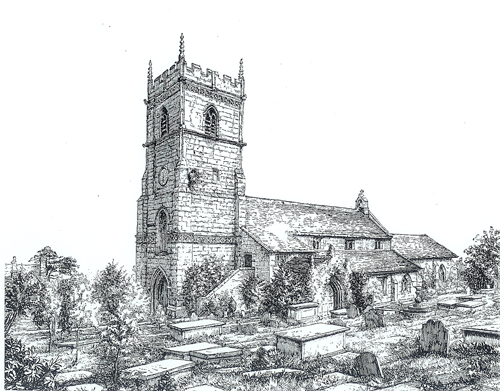 Public worship in Latin was abolished by the Acts of Uniformity. A pulpit was erected in 1560. The high altar and the rood loft were taken down during the years 1563-72 and a moveable Communion table was set up.
Public worship in Latin was abolished by the Acts of Uniformity. A pulpit was erected in 1560. The high altar and the rood loft were taken down during the years 1563-72 and a moveable Communion table was set up.
The church was transformed during the Georgian period to suit the contemporaneous style of worship. Pews (1707) filled the building. In 1710 a canopied three-decker pulpit was erected in the nave. Between 1711 and 1712, a large gallery was built at the western end of the church, with access from external staircases on both sides of the tower. A ceiling was put up in 1719 and decorated in 1720. In 1741-1742, the north aisle was rebuilt.
In a general restoration
designed by Sir George Gilbert Scott
which took place between 1879 and 1888, the pews were replaced, the three-decker pulpit was dismantled, the gallery and the ceiling were removed and the north aisle was again rebuilt.
Further changes took place during the 20th and the first few years of the 21st centuries and no doubt will continue to take place.
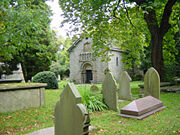 The outstanding feature of the churchyard is the Norman Chapel. Dating from 1175-1190, it began to fall into disrepair a few years after the present church came into use. In 1747 it was rebuilt by Sir William Meredith of Henbury so that his son Amos and other members of his family could be buried there. Restored in 1953, it is now used for a variety of church purposes.
The outstanding feature of the churchyard is the Norman Chapel. Dating from 1175-1190, it began to fall into disrepair a few years after the present church came into use. In 1747 it was rebuilt by Sir William Meredith of Henbury so that his son Amos and other members of his family could be buried there. Restored in 1953, it is now used for a variety of church purposes.
Fragments of a cross of late Saxon
origin were discovered in about 1880 built into the wall of the church. At one time they were thought to date from the late seventh or early eighth centuries, but are now believed to be 10th or 11th century. Pieces of the cross have been put together and now stand in the churchyard near the Norman Chapel. It has been registered as a scheduled monument.
Yew trees in the churchyard date from the time of the Hundred Years' War
.
The sundial (needed to correct the church clock) dates from 1672. It was improved in 1771 but the gnomon is missing.
The forerunner of the Hearse House was built in 1728. The present Hearse House dates from 1852. It is used to store garden tools.
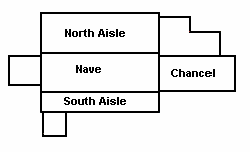 The nave is twenty-two feet wide. The north aisle and the south aisle are twenty-one and ten feet wide respectively. The chancel is nineteen feet wide. The south porch is fifteen feet square. The tower is twenty-three feet square with walls four feet thick. It is seventy-two feet high.
The nave is twenty-two feet wide. The north aisle and the south aisle are twenty-one and ten feet wide respectively. The chancel is nineteen feet wide. The south porch is fifteen feet square. The tower is twenty-three feet square with walls four feet thick. It is seventy-two feet high.
The main body of the church (the nave and chancel) was built during 1220-1230 in the Early English style. The south Aisle and the first north aisle were added in 1310.
The tower and south porch were built around 1480 and are the only parts of the building to survive in essentially their original form.
The clerestory with four windows each side and the bell-cot are early sixteenth century.
In 1612 three of the four fourteenth century windows in the south aisle were replaced by square windows.
The 1741-2 north aisle had five round-headed windows which contrasted with the windows of the south aisle. Two of the round-headed windows survived the general restoration
of 1879-1888.
The vestry to the north of the chancel was added during the general restoration of 1879-1888.
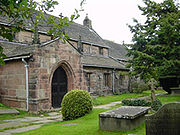
Above the porch is the ringers’ gallery (1637). It was formerly an organ loft. The bells date from 1820. They were recast in 1968.
The roof (1675) replaced an earlier one. The timbering is rough as it was not designed to be exposed.
The nave chandelier is dated 1814. Electric lighting replaced acetylene gas in 1936. Ancient candle brackets remain on the pillars and the south wall.
Paintings above the pillars represent the twelve apostles and the twelve tribes of Israel. They were executed in 1719 by the travelling painter who had decorated the eighteenth century ceiling which was removed as part of the general restoration.
The pulpit is Jacobean
(1607). It was found in 1858 encased in the three-decker pulpit which had been made in 1710. It had replaced the 1560 pulpit.
A fragment of heraldic glass from an early window in the Legh chapel (1601) is now kept in an illuminated cabinet at the west end of the nave, near a memorial book remembering those who lost their lives in the two World Wars.
In 2001 a three-manual Allen Renaissance Digital Organ was installed to replace the pipe organ. At the same time a dais was installed with space for a nave communion table.
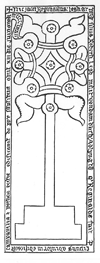 The chancel is entered through a screen which had been erected in 1740 for the Legh Chapel. It has borne the Hanoverian Arms since 1787.
The chancel is entered through a screen which had been erected in 1740 for the Legh Chapel. It has borne the Hanoverian Arms since 1787.
A memorial slab built into the north wall of the sanctuary is the oldest memorial in the church (1482). It commemorates Reginald Legh who helped to build the tower and south porch. This and other slabs were built into the walls when the church was cleared of altar-tombs.
The two-tier chandelier in the chancel is dated 1712.
The east window (1915) represents the river and tree of life as described in Revelations, 22: 1-2. It replaced an earlier window which was had been inserted sixty years previously.
A thirteenth century three-light window in the north side of the chancel is filled with simulated organ pipes.
The main window in the south of the chancel has a representation of Christ’s call of St Peter. It was inserted in 1981. Most of the other glass in the church dates from 1882-1896.
At the east end of the north aisle is the Legh Chantry Chapel, separated from the rest of the aisle by a heavy oak screen.
with a carved head typical of the period projects from the wall.
A small figure of St Nicholas at the top of the east window of the south aisle is 14th Century, the oldest piece of glass in the church.
Parish church
A parish church , in Christianity, is the church which acts as the religious centre of a parish, the basic administrative unit of episcopal churches....
of Prestbury
Prestbury, Cheshire
Prestbury is a village, civil parish and ecclesiastical parish in the unitary authority of Cheshire East and the ceremonial county of Cheshire, England. Prestbury is a long, narrow parish covering 1,165 hectares to the west of the Peak Park foothills and to the east of the sandstone ridge which is...
, Cheshire
Cheshire
Cheshire is a ceremonial county in North West England. Cheshire's county town is the city of Chester, although its largest town is Warrington. Other major towns include Widnes, Congleton, Crewe, Ellesmere Port, Runcorn, Macclesfield, Winsford, Northwich, and Wilmslow...
, England. It is probably the fourth church on the site. The third, the Norman
Norman architecture
About|Romanesque architecture, primarily English|other buildings in Normandy|Architecture of Normandy.File:Durham Cathedral. Nave by James Valentine c.1890.jpg|thumb|200px|The nave of Durham Cathedral demonstrates the characteristic round arched style, though use of shallow pointed arches above the...
Chapel, stands in the churchyard. The church has been designated by English Heritage
English Heritage
English Heritage . is an executive non-departmental public body of the British Government sponsored by the Department for Culture, Media and Sport...
as a Grade I listed building. The Norman Chapel, the lychgate and west wall, the Hearse House, and the sundial in the churchyard are listed Grade II. It is a Church of England parish church
Church of England parish church
A parish church in the Church of England is the church which acts as the religious centre for the people within the smallest and most basic Church of England administrative region, known as a parish.-Parishes in England:...
in the diocese of Chester
Diocese of Chester
The Diocese of Chester is a Church of England diocese in the Province of York based in Chester, covering the county of Cheshire in its pre-1974 boundaries...
, the archdeaconry of Macclesfield and the deanery of Macclesfield.
History
There is compelling evidence that there was a church at Prestbury ("priest’s enclosure") in the Anglo-Saxon eraHistory of Anglo-Saxon England
Anglo-Saxon England refers to the period of the history of that part of Britain, that became known as England, lasting from the end of Roman occupation and establishment of Anglo-Saxon kingdoms in the 5th century until the Norman conquest of England in 1066 by William the Conqueror...
. After the Norman conquest of England
Norman conquest of England
The Norman conquest of England began on 28 September 1066 with the invasion of England by William, Duke of Normandy. William became known as William the Conqueror after his victory at the Battle of Hastings on 14 October 1066, defeating King Harold II of England...
, the church, probably the second on the site, came into the possession of the powerful baron Hugh Kyvelioc
Hugh de Kevelioc, 3rd Earl of Chester
Hugh de Kevelioc, 5th Earl of Chester was the son of Ranulf de Gernon, 4th Earl of Chester and Maud of Gloucester, daughter of Robert, 1st Earl of Gloucester .-Early life:He is thought to have been born Kevelioc in Monmouth...
who gave it to the Abbey of St Werburgh in 1170-1173.
The monks demolished the Anglo-Saxon
Anglo-Saxon architecture
Anglo-Saxon architecture was a period in the history of architecture in England, and parts of Wales, from the mid-5th century until the Norman Conquest of 1066. Anglo-Saxon secular buildings in Britain were generally simple, constructed mainly using timber with thatch for roofing...
church and built what is now called the Norman
Norman architecture
About|Romanesque architecture, primarily English|other buildings in Normandy|Architecture of Normandy.File:Durham Cathedral. Nave by James Valentine c.1890.jpg|thumb|200px|The nave of Durham Cathedral demonstrates the characteristic round arched style, though use of shallow pointed arches above the...
Chapel. The chapel served as a place of worship for the vast Parish of Prestbury until after the Magna Carta
Magna Carta
Magna Carta is an English charter, originally issued in the year 1215 and reissued later in the 13th century in modified versions, which included the most direct challenges to the monarch's authority to date. The charter first passed into law in 1225...
and the deaths of King John
John of England
John , also known as John Lackland , was King of England from 6 April 1199 until his death...
and Pope Innocent III
Pope Innocent III
Pope Innocent III was Pope from 8 January 1198 until his death. His birth name was Lotario dei Conti di Segni, sometimes anglicised to Lothar of Segni....
in 1216.
In 1220, the monks, supported by the Davenports of Marton (and later Henbury), the Piggots of Butley and the family de Corona (predecessors of the Leghs of Adlington
Adlington Hall
Adlington Hall is a country house in Cheshire, England. The oldest part of the existing building, the Great Hall, was constructed between 1480 and 1505; the east wing was added in 1581. The Legh family has lived in the hall and in previous buildings on the same site since the early 14th century...
) started to build what became the chancel and nave of the present church. Rather than incorporate the chapel into the new building, as was often done, they left it in the churchyard. Some time later, it was given to the Davenports for use as a place of burial and perhaps as a private chapel.
During the next three centuries, the church was enlarged and the tower was erected. As a Roman Catholic church
Roman Catholic Church
The Catholic Church, also known as the Roman Catholic Church, is the world's largest Christian church, with over a billion members. Led by the Pope, it defines its mission as spreading the gospel of Jesus Christ, administering the sacraments and exercising charity...
, worship in Latin was conducted at the high altar behind the rood screen
Rood screen
The rood screen is a common feature in late medieval church architecture. It is typically an ornate partition between the chancel and nave, of more or less open tracery constructed of wood, stone, or wrought iron...
. Rich vestments and ornaments were in use.
With the dissolution of the monasteries
Dissolution of the Monasteries
The Dissolution of the Monasteries, sometimes referred to as the Suppression of the Monasteries, was the set of administrative and legal processes between 1536 and 1541 by which Henry VIII disbanded monasteries, priories, convents and friaries in England, Wales and Ireland; appropriated their...
, the Abbey of St Werburgh ceased to exist. The newly-created Diocese of Chester
Diocese of Chester
The Diocese of Chester is a Church of England diocese in the Province of York based in Chester, covering the county of Cheshire in its pre-1974 boundaries...
(1541) administered Prestbury until Sir Richard Cotton purchased the manor and advowson
Advowson
Advowson is the right in English law of a patron to present or appoint a nominee to a vacant ecclesiastical benefice or church living, a process known as presentation. In effect this means the right to nominate a person to hold a church office in a parish...
in 1547. A few years afterwards, in 1580, Thomas Legh of Adlington
Adlington Hall
Adlington Hall is a country house in Cheshire, England. The oldest part of the existing building, the Great Hall, was constructed between 1480 and 1505; the east wing was added in 1581. The Legh family has lived in the hall and in previous buildings on the same site since the early 14th century...
acquired the manor and advowson and became Lay Rector of Prestbury. The Legh family has held the manor and advowson of Prestbury ever since.

The church was transformed during the Georgian period to suit the contemporaneous style of worship. Pews (1707) filled the building. In 1710 a canopied three-decker pulpit was erected in the nave. Between 1711 and 1712, a large gallery was built at the western end of the church, with access from external staircases on both sides of the tower. A ceiling was put up in 1719 and decorated in 1720. In 1741-1742, the north aisle was rebuilt.
In a general restoration
Victorian restoration
Victorian restoration is the term commonly used to refer to the widespread and extensive refurbishment and rebuilding of Church of England churches and cathedrals that took place in England and Wales during the 19th-century reign of Queen Victoria...
designed by Sir George Gilbert Scott
George Gilbert Scott
Sir George Gilbert Scott was an English architect of the Victorian Age, chiefly associated with the design, building and renovation of churches, cathedrals and workhouses...
which took place between 1879 and 1888, the pews were replaced, the three-decker pulpit was dismantled, the gallery and the ceiling were removed and the north aisle was again rebuilt.
Further changes took place during the 20th and the first few years of the 21st centuries and no doubt will continue to take place.
Churchyard
The Lychgate was built in 1715 and re-sited to its present position in 1728.
Fragments of a cross of late Saxon
Anglo-Saxon architecture
Anglo-Saxon architecture was a period in the history of architecture in England, and parts of Wales, from the mid-5th century until the Norman Conquest of 1066. Anglo-Saxon secular buildings in Britain were generally simple, constructed mainly using timber with thatch for roofing...
origin were discovered in about 1880 built into the wall of the church. At one time they were thought to date from the late seventh or early eighth centuries, but are now believed to be 10th or 11th century. Pieces of the cross have been put together and now stand in the churchyard near the Norman Chapel. It has been registered as a scheduled monument.
Yew trees in the churchyard date from the time of the Hundred Years' War
Hundred Years' War
The Hundred Years' War was a series of separate wars waged from 1337 to 1453 by the House of Valois and the House of Plantagenet, also known as the House of Anjou, for the French throne, which had become vacant upon the extinction of the senior Capetian line of French kings...
.
The sundial (needed to correct the church clock) dates from 1672. It was improved in 1771 but the gnomon is missing.
The forerunner of the Hearse House was built in 1728. The present Hearse House dates from 1852. It is used to store garden tools.
Church building

The main body of the church (the nave and chancel) was built during 1220-1230 in the Early English style. The south Aisle and the first north aisle were added in 1310.
The tower and south porch were built around 1480 and are the only parts of the building to survive in essentially their original form.
The clerestory with four windows each side and the bell-cot are early sixteenth century.
In 1612 three of the four fourteenth century windows in the south aisle were replaced by square windows.
The 1741-2 north aisle had five round-headed windows which contrasted with the windows of the south aisle. Two of the round-headed windows survived the general restoration
Victorian restoration
Victorian restoration is the term commonly used to refer to the widespread and extensive refurbishment and rebuilding of Church of England churches and cathedrals that took place in England and Wales during the 19th-century reign of Queen Victoria...
of 1879-1888.
The vestry to the north of the chancel was added during the general restoration of 1879-1888.

Interior
The main west door leads through the West Porch, the Parish's memorial to the dead of the two World Wars.Above the porch is the ringers’ gallery (1637). It was formerly an organ loft. The bells date from 1820. They were recast in 1968.
Nave
Warden’s pews at the west end of the nave survived the general restoration.The roof (1675) replaced an earlier one. The timbering is rough as it was not designed to be exposed.
The nave chandelier is dated 1814. Electric lighting replaced acetylene gas in 1936. Ancient candle brackets remain on the pillars and the south wall.
Paintings above the pillars represent the twelve apostles and the twelve tribes of Israel. They were executed in 1719 by the travelling painter who had decorated the eighteenth century ceiling which was removed as part of the general restoration.
The pulpit is Jacobean
Jacobean architecture
The Jacobean style is the second phase of Renaissance architecture in England, following the Elizabethan style. It is named after King James I of England, with whose reign it is associated.-Characteristics:...
(1607). It was found in 1858 encased in the three-decker pulpit which had been made in 1710. It had replaced the 1560 pulpit.
A fragment of heraldic glass from an early window in the Legh chapel (1601) is now kept in an illuminated cabinet at the west end of the nave, near a memorial book remembering those who lost their lives in the two World Wars.
In 2001 a three-manual Allen Renaissance Digital Organ was installed to replace the pipe organ. At the same time a dais was installed with space for a nave communion table.
Chancel

A memorial slab built into the north wall of the sanctuary is the oldest memorial in the church (1482). It commemorates Reginald Legh who helped to build the tower and south porch. This and other slabs were built into the walls when the church was cleared of altar-tombs.
The two-tier chandelier in the chancel is dated 1712.
The east window (1915) represents the river and tree of life as described in Revelations, 22: 1-2. It replaced an earlier window which was had been inserted sixty years previously.
A thirteenth century three-light window in the north side of the chancel is filled with simulated organ pipes.
The main window in the south of the chancel has a representation of Christ’s call of St Peter. It was inserted in 1981. Most of the other glass in the church dates from 1882-1896.
North aisle
The 13th century font at the west end of the aisle was refaced and recut in 1857. The sculptured heads may represent monks or lay brothers from the Abbey of St Werburgh.At the east end of the north aisle is the Legh Chantry Chapel, separated from the rest of the aisle by a heavy oak screen.
South aisle
At the east end of the south aisle, the Tytherington Chantry Chapel, dedicated to St Nicholas, was created in 1350. A 14th century piscinaPiscina
A piscina is a shallow basin placed near the altar of a church, used for washing the communion vessels. The sacrarium is the drain itself. Anglicans usually refer to the basin, calling it a piscina. Roman Catholics usually refer to the drain, and by extension, the basin, as the sacrarium...
with a carved head typical of the period projects from the wall.
A small figure of St Nicholas at the top of the east window of the south aisle is 14th Century, the oldest piece of glass in the church.
Vicars of Prestbury
- 1230 Master Hugh
- 1275 Walter de Kent
- 1300 Walter de Norton
- 1320 John Secular
- 1350 Richard Pygott
- 1360 John de Bellerby
- 1369 Richard de Bontable
- 1377 John del Schagh
- 1416 John Duncalf
- 1448 Nicholas Byrd
- 1468 Richard Broadhurst
- 1475 Richard Smyth
- 1512 John Parsons
- 1530 Ralph Green
- 1559 Edmund Newson
- 1584 John Booth
- 1627 Thomas Jeynson
- 1667 William Shippen
- 1675 George Newton
- 1691 Benjamin Spanne
- 1693 William Foxlowe
- 1722 Joseph Lowe
- 1733 Edward Darell
- 1738 Joseph Ward
- 1772 Peter Mayer
- 1786 John Watson
- 1800 John Rowlls Browne
- 1843 Henry Pearson
- 1858 Stephen Lea Wilson
- 1889 Reginald Edmund Broughton
- 1929 Auberon Elstob
- 1936 George Archibald Hope
- 1950 Harold William Rogers
- 1981 David William Moir
- 1996 David Ashworth
- 2006 Patrick John Mark Angier

